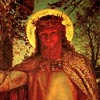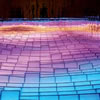This theme is included in the art techniques because it affects the shapes, the composition and configuration of the work. The artist must decide between using the representation and the figuration or to use the abstraction and the graphic elements in the creation. The message of the work can be from concrete ideas to more abstract ideas.
These decisions in the shape can be gradual, i.e., we can be using both modes simultaneously, figuration and abstraction.
We could think that the big difference between those expressive systems is the wish of the artist on specify his message. But this is not so. We must remember that it is the spectator who sets the final message, according to their knowledge and experience.
The figuration provides concrete objects, but the composition can be so much complex that although all the shapes materialize concrete ideas, the set could be very ambiguous and open thought.
For example the work of David Hockney:
The Great dip, by David Hockney, 1967
It’s a picture with very concrete, very realistic shapes, but … what is the message? There are some variety of sensations that only the spectator can feel, and according to these feelings, the artwork will be undestood.
Moreover, although the abstract shapes usualy do not define the theme and the message and they are more difficult to undestand, there are abstract paintings that contradict this idea. I think Mondrian is a good example because his intention was very direct. For example what he wanted to express was a very specific topic: serenity and balance. And using abstraction his message is clear and direct. Perhaps because the abstract shapes that he uses are themselves very strong elements of balance; horizontal and vertical lines.
Although it is an abstract concept, the truth is that Mondrian’s abstract works must not be thought ambiguously, but concretely.
For example this artwork by Piet Mondrian:
Composition 10 by Piet Mondrian, 1939-42
Understood the expressive complexity discussed above, we will consider, however, that the abstract elements are more ambiguous and that the figuration is more specific in it message. This way, we can reason about it and create a message. Without taking this false generalization it would be too complex to concrete the forms and to decide that we want to use.
That is, although it is not always true, we are going to consider that:
Abstraction = ambiguous message
Figuration = specific message
Below I present a list of possible combinations between the two expressive elements.
COMBINATIONS: Written Language + Abstraction + Figuration.
1. Accurate Figuration.
Photography or hyper realist painting + specific linguistic message = Message pushed hard towards specifying and exact definition.
2. Figuration released with text.
Stylized Figuration + specific linguistic message = message forced with a concrete written message but withh the images more ambiguously.
3. Figuration released.
Stylized Figuration + abstract linguistic message or without text = Message less forced and open to the ambiguity of the images. Abstract text works as a graphic image, not as a language.
4. Minimum Figuration.
Figurative images are false representations of the reality and thus extend the ambiguity and the various sensations.
5. Abstraction with text.
No Figuration + specific linguistic message = Message forced by the text but open because of the ambiguity on the images.
6. Pure Abstraction
No Figuration + Great ambiguity










